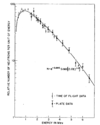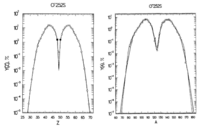Difference between revisions of "Cf252 runs with HPGe"
| Line 108: | Line 108: | ||
| 5639 || 371 || 235 || 1425 || 10" poly. || 134,095 || | | 5639 || 371 || 235 || 1425 || 10" poly. || 134,095 || | ||
|- | |- | ||
| − | | | + | | 5641 || || - || - || - || -- || || CO-60 + Na-22 cal. run |
|- | |- | ||
|} | |} | ||
Revision as of 22:17, 10 January 2017
Detector efficiency measurements using a Cf-252 source.
Cf-252 source description
Serial Number: FTC-CFZ-431 Z=98 Mass:A document indicates that on 03/19/1993 the Cf-252 mass was 4.2. ( is expected to emit )
Half Life= 2.652 years
Neutron fluence:A document indicates that on 03/19/1993 the Cf-252 the neutron rate was measured(?) to be . Based on the mass one would expect .
Neutron energy spectrum (from A.B.Smith et.al, Physics. Rev. Vol 108 #2 pg 411-414, 1957 File:PhysRev108p411957.pdf):
Decay: Cf-252 undergoes alpha decay to Curium (cm-248) 96.9% of the time. The rest of the time it will undergo spontaneous Fission emitting 3.7 neutrons on average per fission.
The Fission Fragment Yield as a function Fission fragment Atomic Number () and Atomic Mass Number () from Wahl, A., At. Data and Nuc. Data Tab., vol. 39, (1988) .
most likely observable isotopes:
40<Z<45 and 53<Z<58
Previously measured Gamma spec
Fragments to try and observe:
= Ac-228
Bi-214
Tl-208
HpGe distribution
Test Run 5603 may be seeing Bi-214 line 1145 keV
HpGe Neutron Damage
I made a page discussing neutron damage to the HPGe detector (Fast_neutron_damage_to_HPGe_Detector) as a function of the total amount of fast neutrons per irradiated on the detector face. is a factor of 10 below the point where damage was first observed in an experiment.
RunPlan
Object: Determine if an HpGe detector can be using to tag neutrons and identify the isotope species parent of the neutron
HpGe Singles measurement
Measure the energy distribution observed by the HpGe detector
Determine optimal neutron shielding between HpGe detector and Cf-252 source
Small Scintillator position
Determine how close the small scintillator can be positioned without having detected neutrons overwhelm detector photons. Want to be sure the small scintillator is detecting photons most of the time
Determine timing resolution of HpGe Detector
Estimate run time for efficiency measurement
Runlist
12/29/16
No poly was used to shield the HPGe detector.
| Run # | RunTime [sec] | distance[cm] | n flux (Cf252 rates) |
Integral n flux |
configuration | notes |
|---|---|---|---|---|---|---|
| 5609 | 4060 | 30 | 6850 | 6850 | Cf252 in. Coincidence between HPGe and timing PMT | A ToF spectrum exists but is very hectic. Problem may be that the TDC stop is determined by a widened timing PMT pulse in coinc. with a HPGe pulse that has high timing jitter. |
| none | 1250 | 26 | 2800 | 9655 | Not taking data during this time. | |
| 5611 | 2509 | 30 | 4230 | 13885 | Cf252 in. Coincidence between HPGe and timing PMT. TDC stop was changed to always be 1200 ns after PMT timing pulse, otherwise same setup as 5609. | ToF looks good. Neutron rate approx. 3 Hz for detector 90. |
| 5613 | 10025 | 15 | 0 | 13885 | Na-22 source. Coincidence between HPGe and timing PMT | Calibration |
| 5614 | 654 | 15 | 0 | 13885 | Co-60 source. Coincidence between HPGe and timing PMT | Calibration |
| Total n flux: 13885 n/cm^2 | ||||||
01/01/17
CF-252 source is kept at a fixed distance while the thickness of poly between src and HPGe is increased by increments of 2".
| Run # | RunTime [sec] | distance[cm] | n flux (Cf252 rates) |
Integral n flux |
configuration | num events | notes |
|---|---|---|---|---|---|---|---|
| 5633 | 372 | 49 | 235 | 235 | No poly. | 303,929 | |
| 5634 | 371 | 235 | 470 | 2" poly. | 250,495 | ||
| 5635 | 371 | 235 | 705 | 4" poly. | 202,942 | ||
| 5637 | 397 | 256 | 956 | 6" poly. | 181,667 | ||
| 5638 | 371 | 235 | 1190 | 8" poly. | 147,801 | ||
| 5639 | 371 | 235 | 1425 | 10" poly. | 134,095 | ||
| 5641 | - | - | - | -- | CO-60 + Na-22 cal. run |






